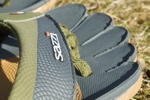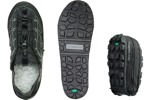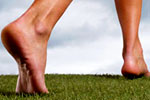If you had to spend an entire vacation wearing no other footwear besides a pair of flip-flops which model would you want to take?
Spot Cool Stuff has been busy lately researching this exact question. We’ve been testing more than two dozen pairs of flip-flops across several categories. But there’s one model we are already certain will make our final cut: the Sazzi Decimal Sandal.
One needn’t look at a Sazzi Decimal for more an instant to spot its two most pronounced features: the four toe posts and the footbed with individual toe cutouts.
Continue →
 Making a fully waterproof running and hiking shoe is really hard. Doubly so if you want that shoe to be lightweight. Sealing the seams and using water-resistant fabrics can help. But if you spend enough time stomping around in enough water, every “waterproof” shoe will eventually be breached.
Making a fully waterproof running and hiking shoe is really hard. Doubly so if you want that shoe to be lightweight. Sealing the seams and using water-resistant fabrics can help. But if you spend enough time stomping around in enough water, every “waterproof” shoe will eventually be breached.
So in the spirit of If you can’t beat ‘em, join ‘em, Columbia is introducing their Powerdrain hybrid water shoe. It has a drainable footbed, with points in both the heel and forefoot—so when water does get into the shoe it can easily flow out.
Continue →
 Shoes are luggage space hogs. When we pack shoes we usually stuff the insides with socks and underwear. But we like this idea better: Shoes that fold up. Like the colorful Timberland Radler Trail Camp line.
Shoes are luggage space hogs. When we pack shoes we usually stuff the insides with socks and underwear. But we like this idea better: Shoes that fold up. Like the colorful Timberland Radler Trail Camp line.
Radler Trail Camps don’t only fold closed. They zip closed too. That thanks to the zipper that rings the shoe’s 42% recycled rubber lug outsole. (The zipper, fortunately, is mostly hidden from view when the shoe is open). When zipped closed, a 225g (8 oz) Radler Trail Camp is compact enough to fit into a jacket pocket.
Continue →
Question: What’s the single best designed piece of running equipment?
Answer: It’s a pair of gear you already own—your bare feet.
Most running shoes, it turns out, do more harm than good. The problem is that these shoes are designed to “protect” your feet in a way that they weren’t meant to be. When encased in an excessively built-up running shoe the muscles, tendons and ligaments of your lower extremities will atrophy. That’s because your shoes are doing the work that your legs and feet should be doing.
The other problem with running shoes is that they encourage you to run with the wrong form. Your body is designed to run on the ball and forefront of your feet. Try going for a run barefoot and you’ll experience this yourself—your heels will barely touch the ground. In contrast, most running shoes will cause you to land on your heels in a way that won’t only slow you down but will inevitably lead to knee and back pain.
Shoes, of course, do serve a purpose. They keep your feet cleaner and drier than bare feet, not to mention being useful when there’s a sharp rock or nail under foot.
So what’s an athlete to do? Get a pair of running shoes with a design that mimics the advantages of your bare feet. Here are our two favorite:
Continue →























